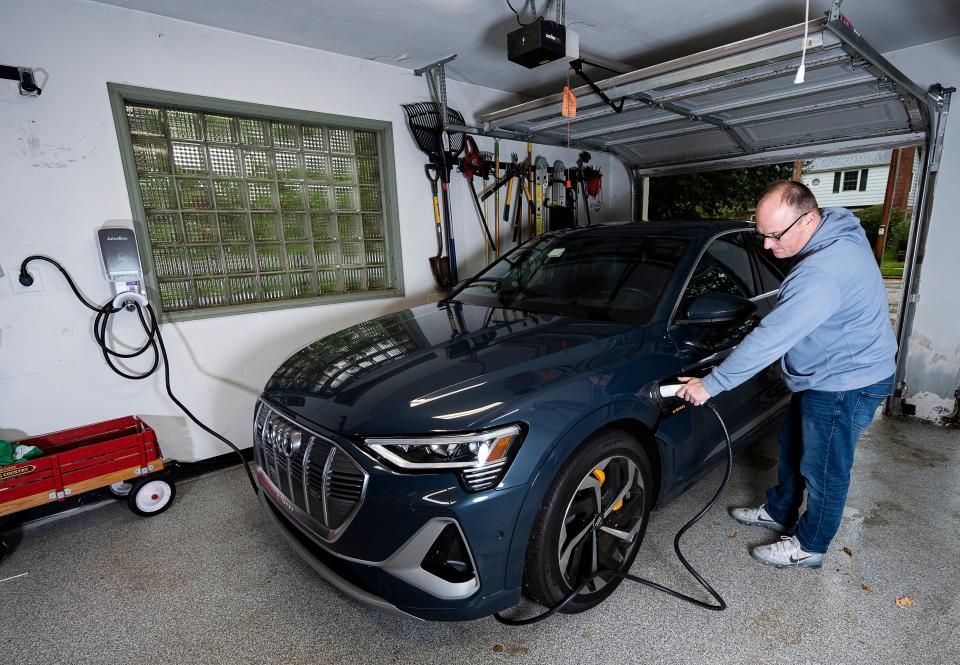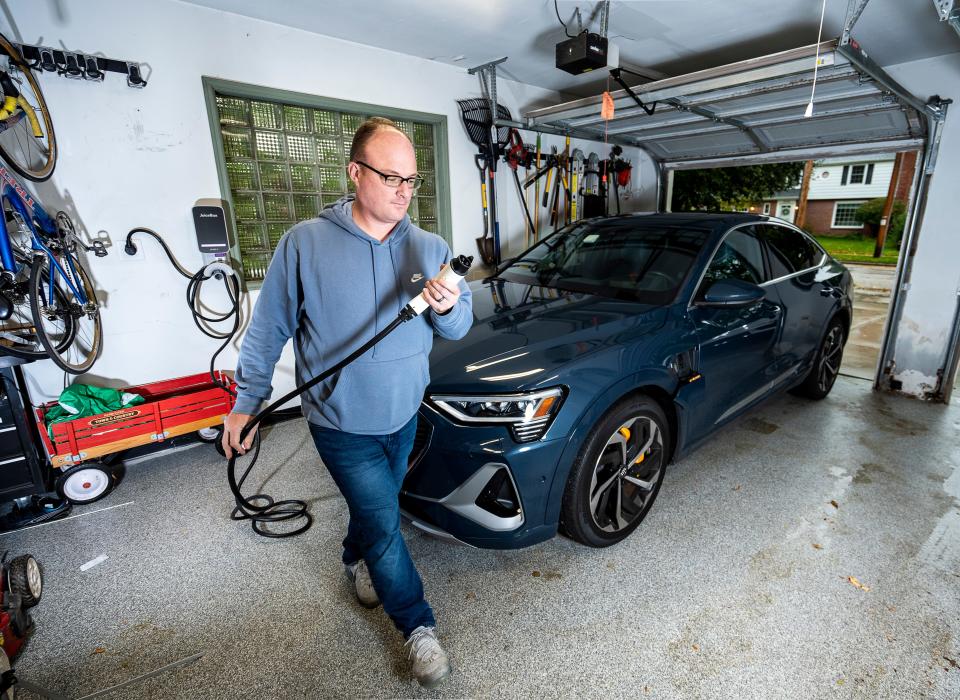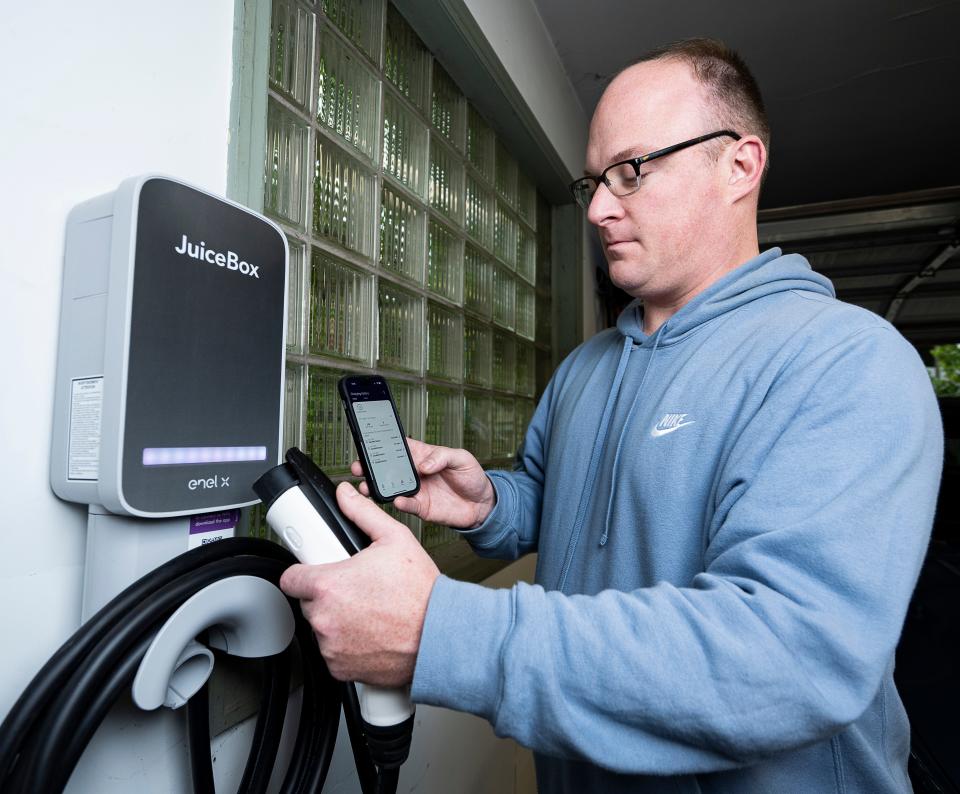Buying an electric car or truck? Don't ignore the cost of wiring your home for EV charging
A slew of TV ads that aired late last year touting new EV offerings may have been a little premature.
Supply chain and manufacturing delays meant 2023 started slow for many of the established names and new companies hoping to make a dent in Tesla's dominance of the EV market.
But that's been changing as inventories slowly built up, and it should accelerate this fall. Manufacturers have announced they expect to begin delivery of 16 new models by the end of the year, according to Car and Driver, and that's just the first salvo in a push that will bring nearly 50 new models to market by the end of next year.
Even without a lot of new product on the lots, EV sales in the U.S. in the first half of the year were nearly 50% higher than a year ago, spurred by greater selection and federal rebates, and Cox Automotive projects more than 1 million vehicles will be sold in 2023. The company also found that about half of consumers are now considering either a new or used EV.
Growing inventories, falling prices and federal tax rebates are expected to make EV ownership more tempting for those considering a new vehicle. But before making the leap, there's a key question to ask: is your garage ready to charge a vehicle and, if not, what will it cost to get there?
Basic EV charging equipment is just that
New vehicles typically come with a charger that can plug into a typical three-prong, 120-volt wall outlet.
That's convenient, but do you really want to do that? The answer depends on your expectations and driving habits.
A basic wall-outlet charger, known as a Level 1 charger, can only add 3 to 6 miles of driving range per hour - that means you could wait half a day just to top off after a 40-mile trip. To fully recharge a car with an average EV range of about 300 miles, you're looking at days to get from near empty to full.
Motor Trend: Buying a Rivian R1T electric pickup truck was a miserable experience.
And, contractors warn, it might not be safe with existing outlets and wiring, which should be checked out by an electrician, especially in older houses.
"Hardly anyone does it," said Jeremy Giese, president and owner of Ideal Electric, a regional contractor based in West Bend, Wisconsin.

There's a better EV charging choice, but it comes with a cost
Andrew Tilley of Wauwautosa, Wisconsin, lived with Level 1 charging for about a month after he bought his first electric vehicle in August, a used 2020 Audi e-tron. He knew right away that he wanted a faster charger, known as a Level 2 charger, but had to wait until an electrician was available to do the work.
"What I was literally doing was trickle charging off of an electrical outlet in the wall, and that charged, like three miles every hour, whereas now I charge like 30 miles an hour," he said.
Level 2 chargers have become the home-charging standard. These chargers, which cost from about $300 to more than $1,000 excluding installation, can add 25 to 40 miles of driving range an hour. That's less than high-speed Level 3 chargers, the type increasingly seen at public charging stations, but a Level 2 charger comes at a much more reasonable price and meets virtually anyone's needs.
However, installing a Level 2 charger does carry additional costs.
According to a We Energies home charging estimator, installing a Level 2 charging station in your garage can cost as little as $900 if the house already has 200 amp electrical service, a properly sized circuit breaker box with two empty slots for a 240-volt electric feed.
But that's not every home. The cost can quickly add up in older buildings where the wiring and electrical panels may need to be upgraded to meet the charging system's needs, Giese said.
That could add $2,600 to $5,700 to the cost of a charger installation.
Where the breaker box is located in the house can also make a difference. Things are easy if it's in or near the garage, more expensive if it's in the basement and far from the garage, and even more costly if a buried power line needs to be extended to a detached garage.
Given all the variables, there's really no such thing as an average price, but contractors said a good ballpark cost for upgrading an older house to support EV charging would be about $4,000 to $5,000.
"Just to get the plug for the faster charging could potentially end up costing you an additional 10 grand on the high end," said Eric Pena, owner of Crown Electrical in Cedarburg. "A lot of people don't think about that until after the fact, unfortunately."
Tilley said he paid about $2,500 to run a 240-volt line from his breaker box to a new outlet in the garage and another $600 for the charger itself. That was a little more than he'd budgeted, but he said the cost was well worth it for the convenience and also because there are only a handful of public stations where he can quickly refuel after longer trips.
"Once I was trickle charging, it was like a no-brainer – I had to get the charger installed," he said" "A few hundred dollars more really wasn't gonna matter at that point because we really don't have any charging infrastructure around here."

Can you get by with a Level 1 EV charger?
Erinn Monroe-Nye, energy services and policy manager for Madison Gas & Electric, knows firsthand the answer is yes. She used a Level 1 charger for a couple of years after buying a Tesla Model 3.
Starting out with a Level 1 charger, she said, can reduce upfront costs when buying an EV, and it's not much of a sacrifice for the majority of drivers ‒ those who use their vehicles primarily for daily commutes and short in-town trips.
"If you're plugging in overnight that means you're going to get between 30 and 50 miles of charge on a standard outlet. For a lot of people that are mostly commuting within town, that's enough," she said.
There is one caveat, though. People who live in older homes with 100-amp electrical service may find they will max out their power supply if they're charging a vehicle while also running air conditioning or other energy-hungry appliances.
That's why it's always a good idea to consult with an electrician early in the car shopping process, regardless of the charging system you intend to install, Pena said.
"You'll know going into it if there's going to be additional costs for when you buy the car," he said. "Then at least when you buy it you're prepared, or you know your service is good and we'll be able to add the charger and there shouldn't be any additional costs outside of just purchasing the vehicle."

Why not an EV: Here's why people aren't buying EVs in spite of price cuts and tax breaks.
Utilities can help you navigate, save on EV charging
Regardless of the charger, refueling at night can be a significant cost saver.
All of Wisconsin's major utilities offer some form of time-of-use rates to encourage vehicle charging at night, when electricity demand is at its lowest. We Energies, for example, offers an overnight rate that's less than half as expensive as peak daylight hours.
Under a pilot program that's also offered to customers at its sister utility, Wisconsin Public Service Corp., EV owners can buy or lease a charger valued at about $600, and pay a monthly fee of $8 or $20 (if the charger is leased) to participate.
Charging is controlled by an app and the vehicle's onboard computer, so you can plug the vehicle in any time.
Tilley bought his charger from We Energies and enrolled in the utility's time-of-use program. He said it was an easy decision both because of the cost savings and because the charger includes a warranty and service program.
Alliant Energy offers similar savings through its night and weekend program, which carries an additional charge of $15.
MG&E also offers time-of-use rates. It also has a program called Charge Ahead, an app-based managed charging program that allows the utility to shift or slow charging during times of peak electricity demand or reduced renewable energy production. To encourage participation, participants are paid $4 a month in winter and $8 a month in summer.
All of these programs aim to find solutions for a time when EVs are more fully embraced and managing electricity demand will be crucial for the reliable operation of the electric grid.
"Right now, EVs are only accounting for about 1% of the cars on the road but we expect that to grow pretty quickly, especially with all the incentives out there. That's what we're trying to plan for," Monroe-Nye said.
This article originally appeared on Milwaukee Journal Sentinel: Electric car, truck chargers are cheap, home installation may be another story

 Yahoo Finance
Yahoo Finance 